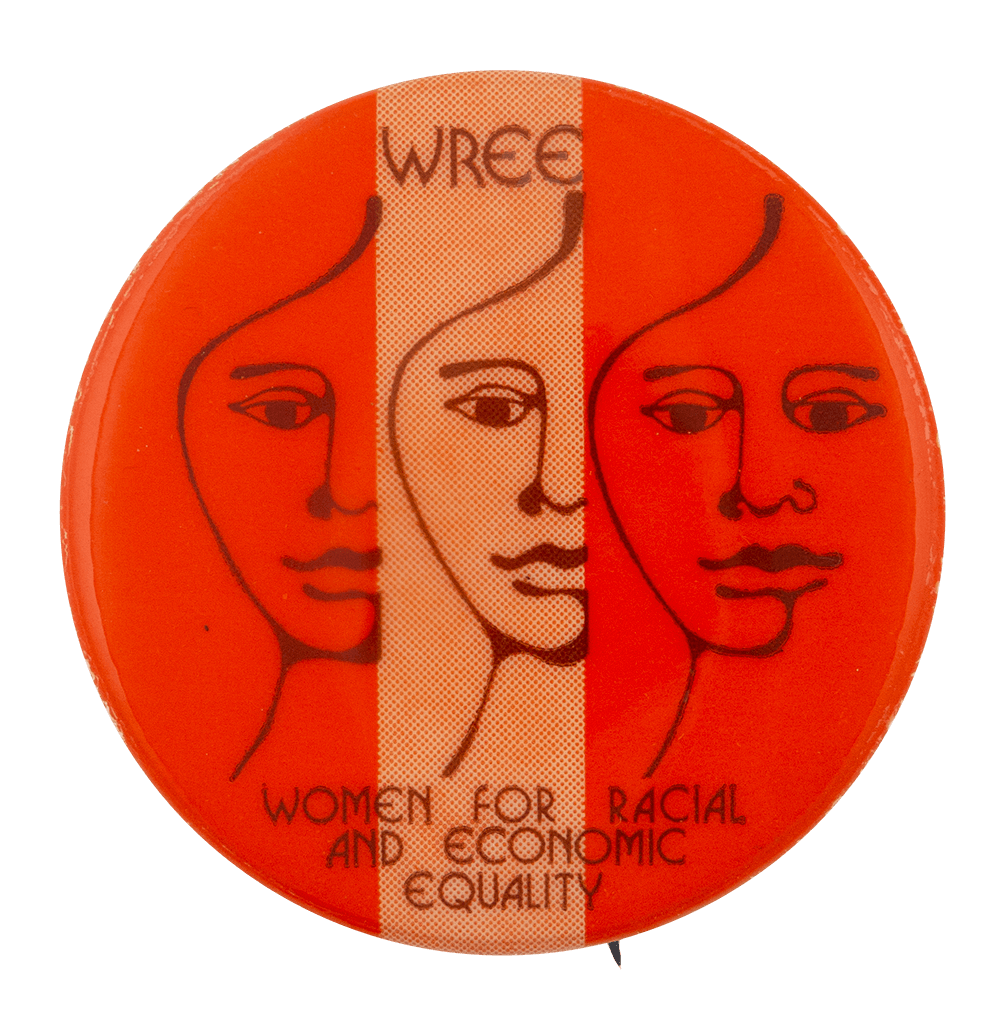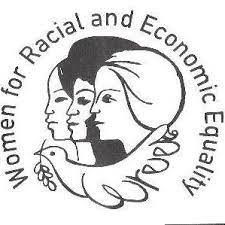
Women for Racial and Economic Equality, also known as WREE, was an organization founded by the Communist Party USA. The Communist Party USA is the oldest Marxist-Leninist organization in the United States. Simplified, communism is a political theory based on Karl Marx’s beliefs that supports the elimination of classes by publicly owning all property and paying people to work to their abilities and needs. Communism and the notion of Communist activities have historically been unpopular and notably career-ending in the United States, especially during the active years of the WREE. WREE memorabilia including wearables promoting their organization and beliefs may have been seen as a bold statement of political affiliation during a politically-charged arena.
Communism had been a difficult concept in the United States for decades, dating back to the First Red Scare in the late 1910s. Many people believed that the Communist party was seeking to gain a foothold in America. While there is a long-shared history of back and forth between capitalism and communism, one notable organization that succeeded in spreading communist ideals in the United States was WREE. While Women for Racial and Economic Equality was highly scrutinized by many for their roots, which had been founded by the Communist Party USA in the 1970s. Not all women involved claimed to be a part of the Communist Party, but rather sought out membership and authorship because of the views and values of the organization which supported women’s rights, minority rights, and the rights of the underprivileged.
The organization put out a bi-monthly bulletin called “The WREE-VIEW,” which was published in New York. While some did include names, many contributors chose to remain a sense of anonymity when published in the newspaper. WREE put out statements that catered to female audiences, especially female racial minority groups. One of the statements that was included in multiple (if not every) issue covered the “women’s bill of rights,” which listed twelve rights of women on which the Women for Racial and Economic Equality based their work. Those rights are: 1) Peace and security, an end to the arms race, freedom from racist and sexist violence; 2) A safe job at a living wage or a guaranteed annual income; 3) Equal pay for equal or comparable work; 4) Affirmative action to end discrimination in training, hiring, and promotion; 5) Organize the unorganized women to make the trade union movement reflect the interests of all workers; 6) A culture free from racist and sexist images of women, and which reflects our multinational history and multilingual character; 7) Federally funded nonracist, nonsexist child care for all who want or need it; 8) Federally funded nonracist, nonsexist public education; 9) A federally funded national health care system; 10) Full reproductive freedom, including maternity leave with pay, the right to federally funded abortion, and an end to experimentation and sterilization abuse; 11) Decent affordable house; and 12) An environment free from toxic wastes and industrial pollution.

The organization’s appeal was held in the inclusivity of the group as coupled with the logical and emotional draw to audiences. Publishing poetry, articles in multiple languages, and topics relevant to women, the “WREE View of Women for Racial and Economic Equality” also published articles against the Reagan administration and calls to boycott specific companies. Alongside all of these are sometimes articles that praised communist ideals and criticized capitalism.
While the history of WREE and the facts surrounding their founding are fascinating, the key point to the views of Women for Racial and Economic Equality is that many of their ideals that they fought for are still relevant and topics of contention. Is it better for children to attend preschool (as discussed in “Potential of Preschool Education”)? Is it purely a woman’s right to choose, or should the government be able to outlaw abortion (as mentioned in “Silence No More” and “Most Innocent of All!”)? Should CEOs and upper-level management who support unethical practices risk backlash against their companies for personal statements (as touched on in “Why We Boycott Products”)? When is injustice and lack of safety in the workplace the public’s concern (as discussed in “Affirmative Action in Coal Mines”)? Many articles discuss these topics and others of value in present day discussions.
Browsing through issues of WREE unashamedly called for sexist, racist, and prejudiced individuals, companies, etc. to be boycotted by WREE members. During a time when boycotting was not uncommon, WREE took action to a higher level by publishing entire articles on why such individuals and companies should be avoided and confronted by the masses. Surprising for a newspaper that’s 35 years old, WREE’s publications have maintained a sense of relevancy because many of the topics covered were progressive for the time.
A major aspect of WREE was calling members to action. This included more than boycotting companies. Ads were shared in the newspaper that called readers to take part in various events, such as the International Shadow Project on August 6, 1985. The Shadow Project commemorated the lives lost due to the bomb dropped on Hiroshima. This was not the only project or event that WREE called readers to take part in. Much of what WREE promoted showed the importance of humanity and the fight for equal rights for all.
Sources:
Bonpane, B. (1985). What is “anti-communism”? [Editorial]. WREE View of Women for Racial and Economic Equality, 10(4), 2. https://voices.revealdigital.org/?a=d&d=BBAGDHHC19850801.1.3&e=-------e…
Women for racial and economic equality. (2019, December 27). Retrieved July 24, 2020 from https://keywiki.org/Women_for_Racial_and_Economic_Equality
